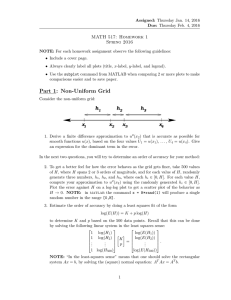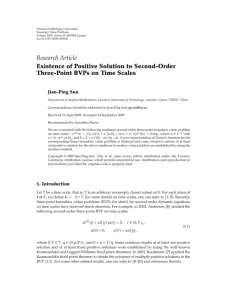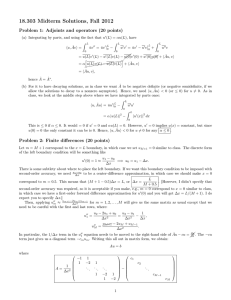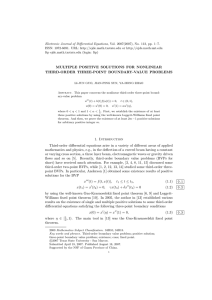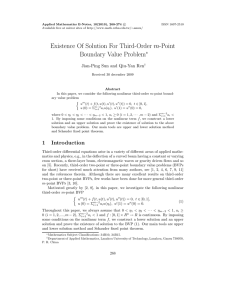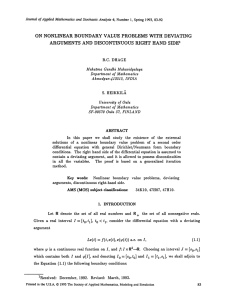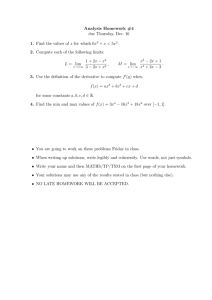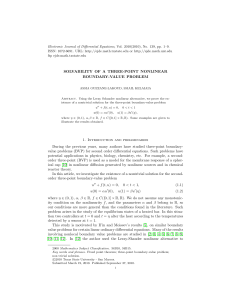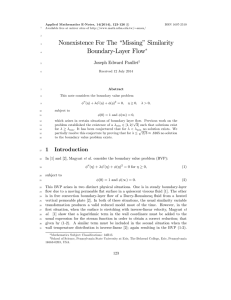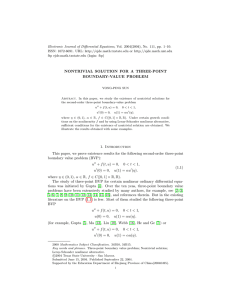Electronic Journal of Differential Equations, Vol. 2008(2008), No. 41, pp.... ISSN: 1072-6691. URL: or
advertisement
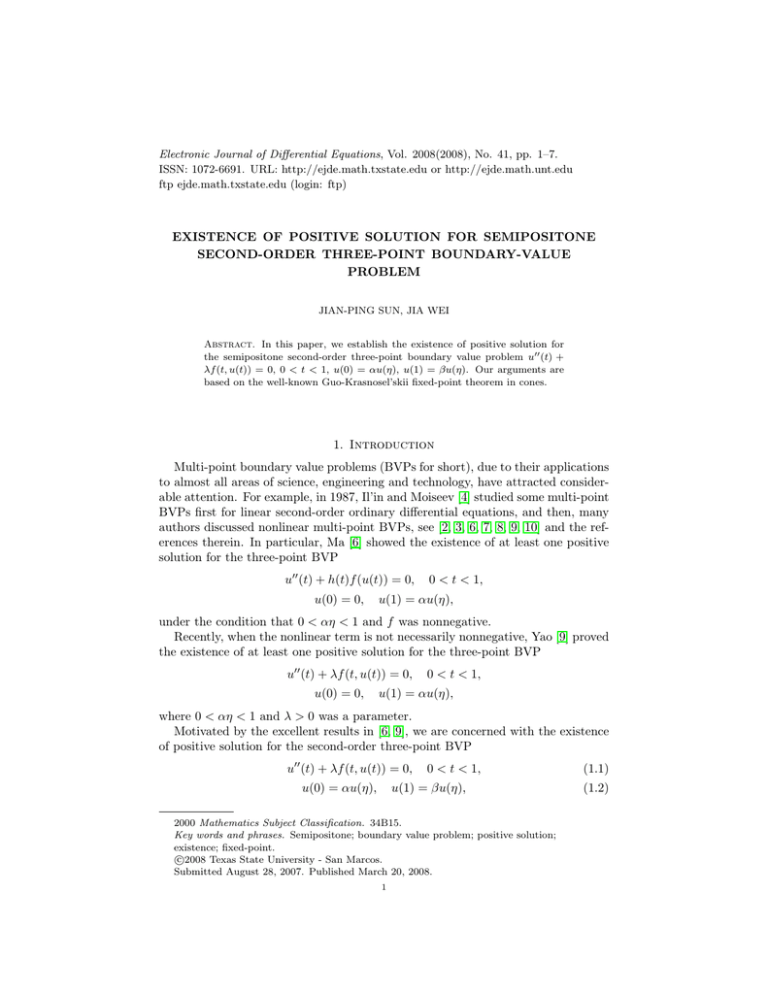
Electronic Journal of Differential Equations, Vol. 2008(2008), No. 41, pp. 1–7.
ISSN: 1072-6691. URL: http://ejde.math.txstate.edu or http://ejde.math.unt.edu
ftp ejde.math.txstate.edu (login: ftp)
EXISTENCE OF POSITIVE SOLUTION FOR SEMIPOSITONE
SECOND-ORDER THREE-POINT BOUNDARY-VALUE
PROBLEM
JIAN-PING SUN, JIA WEI
Abstract. In this paper, we establish the existence of positive solution for
the semipositone second-order three-point boundary value problem u00 (t) +
λf (t, u(t)) = 0, 0 < t < 1, u(0) = αu(η), u(1) = βu(η). Our arguments are
based on the well-known Guo-Krasnosel’skii fixed-point theorem in cones.
1. Introduction
Multi-point boundary value problems (BVPs for short), due to their applications
to almost all areas of science, engineering and technology, have attracted considerable attention. For example, in 1987, Il’in and Moiseev [4] studied some multi-point
BVPs first for linear second-order ordinary differential equations, and then, many
authors discussed nonlinear multi-point BVPs, see [2, 3, 6, 7, 8, 9, 10] and the references therein. In particular, Ma [6] showed the existence of at least one positive
solution for the three-point BVP
u00 (t) + h(t)f (u(t)) = 0,
u(0) = 0,
0 < t < 1,
u(1) = αu(η),
under the condition that 0 < αη < 1 and f was nonnegative.
Recently, when the nonlinear term is not necessarily nonnegative, Yao [9] proved
the existence of at least one positive solution for the three-point BVP
u00 (t) + λf (t, u(t)) = 0,
u(0) = 0,
0 < t < 1,
u(1) = αu(η),
where 0 < αη < 1 and λ > 0 was a parameter.
Motivated by the excellent results in [6, 9], we are concerned with the existence
of positive solution for the second-order three-point BVP
u00 (t) + λf (t, u(t)) = 0,
u(0) = αu(η),
0 < t < 1,
u(1) = βu(η),
2000 Mathematics Subject Classification. 34B15.
Key words and phrases. Semipositone; boundary value problem; positive solution;
existence; fixed-point.
c
2008
Texas State University - San Marcos.
Submitted August 28, 2007. Published March 20, 2008.
1
(1.1)
(1.2)
2
J.-P. SUN, J. WEI
EJDE-2008/41
where 0 < η < 1, 0 < β ≤ α < 1, λ > 0 is a parameter. Throughout, we assume
that there exists a constant M > 0 such that f : [0, 1] × [0, +∞) → (−M, +∞)
is continuous. This implies that the BVP (1.1) and (1.2) is semipositone. For
convenience, we denote
ξ = 1 − α + (α − β)η,
αη
(1 − η)α γ = min
,
,
1 − α + αη 1 − βη
B = max{f (t, u) + M : (t, u) ∈ [0, 1] × [0, 1]}.
The main result of this paper is the following theorem.
Theorem 1.1. Suppose that limu→+∞ min0≤t≤η f (t,u)
= +∞. Then the BVP (1.1)
u
and (1.2) has at least one positive solution for
2γβξ
2ξ
.
,
0 < λ < min
2
B(1 − α + αη) αM (1 − α + αη − βη )
Our main tool is the well-known Guo-Krasnosel’skii fixed-point theorem, which
we state here for convenience of the reader.
Theorem 1.2 ([1, 5]). Let E be a Banach space, K a cone in E and Ωc = {u ∈
K : k u k< c}. Suppose that T : K → K is a completely continuous operator and
0 < a < b < +∞ such that either
(1) T u u for u ∈ ∂Ωa and u T u for u ∈ ∂Ωb , or
(2) u T u for u ∈ ∂Ωa and T u u for u ∈ ∂Ωb .
Then T has a fixed point in Ωb \ Ωa .
2. Preliminaries
In the remainder of this paper, we assume that 0 < β ≤ α < 1. Also let the
Banach space E = C[0, 1] be equipped with the usual norm kuk = maxt∈[0,1] |u(t)|.
Lemma 2.1. For any fixed y ∈ E, the BVP
u00 (t) + y(t) = 0,
u(0) = αu(η),
0 < t < 1,
(2.1)
u(1) = βu(η)
(2.2)
has a unique solution
Z t
Z 1
1
u(t) = −
(t − s)y(s)ds + [(1 − α)t + αη]
(1 − s)y(s)ds
ξ
0
0
Z η
1
(η − s)y(s)ds.
+ [(α − β)t − α]
ξ
0
Since the proof of the above lemma is easy, we omit it.
Lemma 2.2. If y ∈ E and y ≥ 0, then the unique solution u of the BVP (2.1)–(2.2)
satisfies u(t) ≥ 0 for t ∈ [0, 1].
Proof. Since u00 (t) = −y(t) ≤ 0, 0 < t < 1 it follows that the graph of u(t) is concave
dawn, we only need to prove u(0) ≥ 0 and u(1) ≥ 0. In view of 0 < β ≤ α < 1 and
(2.2), we know that u(0), u(η) and u(1) have same signs. Suppose on the contrary
that u(0) < 0, u(η) < 0 and u(1) < 0. Then we have
u(η) =
u(0)
< u(0),
α
u(η) =
u(1)
< u(1) .
β
EJDE-2008/41
EXISTENCE OF POSITIVE SOLUTIONS
3
Then
u(η) < min{u(0), u(1)},
which contradicts the concavity of u. Thus, we get that
u(0) ≥ 0
and u(1) ≥ 0
as required.
Lemma 2.3. If y ∈ E and y ≥ 0, then the unique solution u of the BVP (2.1)–(2.2)
satisfies
min u(t) ≥ γkuk.
(2.3)
0≤t≤η
Proof. Since u(0) = αu(η), 0 < α < 1 and Lemma 2.2 imply that u(0) ≤ u(η), we
know that
min u(t) = u(0).
(2.4)
0≤t≤η
Set u(t) = kuk. We consider the following two cases:
Case 1. η ≤ t. It follows from the concavity of u that
u(t) − u(0)
u(η) − u(0)
≥
.
η−0
t−0
Combining the boundary condition u(0) = αu(η), we conclude that
αη
αη
u(t) =
kuk,
u(0) ≥
1 − α + αη
1 − α + αη
which together with (2.4) implies
min u(t) ≥
0≤t≤η
αη
kuk.
1 − α + αη
(2.5)
Case 2. t < η. It follows from the concavity of u that
u(t) ≤
u(1) − u(η)
(0 − η) + u(η),
1−η
which together with (2.4) and the boundary conditions u(0) = αu(η) and u(1) =
βu(η) implies
(1 − η)α
min u(t) ≥
kuk.
(2.6)
0≤t≤η
1 − βη
By (2.5) and (2.6), we know that (2.3) is fulfilled.
Lemma 2.4. The BVP
u
e00 (t) + 1 = 0,
u
e(0) = αe
u(η),
0 < t < 1,
(2.7)
u
e(1) = βe
u(η)
(2.8)
has a unique solution
u
e(t) = −
(1 − α)t + αη + [(α − β)t − α]η 2
t2
+
,
2
2ξ
t ∈ [0, 1].
Remark 2.5. The unique solution u
e of the BVP (2.7)–(2.8) satisfies
u
e(t) ≤
1 − α + αη − βη 2
,
2ξ
t ∈ [0, 1].
4
J.-P. SUN, J. WEI
EJDE-2008/41
3. Proof of Theorem 1.1
Let
g(t, u) = f (t, u) + M,
g(t, u) = g(t, max{u, 0}),
(t, u) ∈ [0, 1] × [0, +∞),
(t, u) ∈ [0, 1] × (−∞, +∞).
Obviously, g : [0, 1] × (−∞, +∞) → (0, +∞) is continuous. We consider the BVP
u00 (t) + λg(t, u(t) − w(t)) = 0,
u(0) = αu(η),
0 < t < 1,
(3.1)
u(1) = βu(η),
(3.2)
where w(t) = λM u
e(t) and u
e(t) is the solution of the BVP (2.7)–(2.8). It is not
difficult to prove that u∗ is a positive solution of the BVP (1.1)–(1.2) if and only if
u = u∗ + w is a solution of the BVP (3.1)–(3.2) and u(t) > w(t), 0 < t < 1.
We define an operator Tλ : E → E:
Z
(Tλ u)(t) = −λ
t
(t − s)g(s, u(s) − w(s))ds
0
Z 1
λ
[(1 − α)t + αη]
(1 − s)g(s, u(s) − w(s))ds
ξ
0
Z η
λ
+ [(α − β)t − α]
(η − s)g(s, u(s) − w(s))ds,
ξ
0
+
t ∈ [0, 1].
It is easy to check that u ∈ E is a solution of the BVP (3.1)–(3.2) if and only if u
is a fixed point of the operator Tλ in E. Therefore, we only need to prove that the
operator Tλ has a fixed point u ∈ E and u(t) > w(t), 0 < t < 1. Denote
K = {u ∈ E : min u(t) ≥ 0, min u(t) ≥ γkuk}.
0≤t≤1
0≤t≤η
Obviously, K is a cone in E. It follows from Lemma 2.3 that Tλ K ⊂ K. Furthermore, we can prove that Tλ : K → K is completely continuous. Now, we introduce
a partial order in E. Let x1 , x2 ∈ E. We say x1 ≤ x2 if and only if x2 − x1 ∈ K.
If we let Ω1 = {u ∈ K : kuk < 1}, then we may assert that
u Tλ u
for any u ∈ ∂Ω1 .
(3.3)
EJDE-2008/41
EXISTENCE OF POSITIVE SOLUTIONS
5
Suppose on the contrary that there exists a u0 ∈ ∂Ω1 such that u0 ≤ Tλ u0 . Since
u0 (t) − w(t) ≤ 1 and (α − β)t − α < 0, 0 ≤ t ≤ 1, we have
u0 (t) ≤ (Tλ u0 )(t)
Z t
= −λ
(t − s)g(s, u0 (s) − w(s))ds
0
Z 1
λ
+ [(1 − α)t + αη]
(1 − s)g(s, u0 (s) − w(s))ds
ξ
0
Z η
λ
+ [(α − β)t − α]
(η − s)g(s, u0 (s) − w(s))ds
ξ
0
Z 1
λ
≤ [(1 − α)t + αη]
(1 − s)g(s, u0 (s) − w(s))ds
ξ
0
Z 1
λ
≤ [(1 − α)t + αη]
(1 − s) max g(s, u0 (s) − w(s))ds
0≤s≤1
ξ
0
Z 1
λ
= [(1 − α)t + αη]
(1 − s) max [f (s, max{u0 (s) − w(s), 0}) + M ] ds
0≤s≤1
ξ
0
Bλ
[(1 − α)t + αη], t ∈ [0, 1],
≤
2ξ
which leads to a contradiction:
1 = ku0 k ≤
Bλ
(1 − α + αη) < 1.
2ξ
So, (3.3) is satisfied.
On the other hand, we claim that there exists a constant σ > 1 such that
Tλ u u
for any u ∈ ∂Ωσ .
(3.4)
In fact, if we let Vλ = {u ∈ K : Tλ u ≤ u} and mλ = sup{kuk : u ∈ Vλ }, then
we only need to prove mλ < +∞. Suppose on the contrary that there exists a
sequence {un }∞
n=1 ⊂ K such that Tλ un ≤ un and kun k → +∞ (n → +∞). Then
for any t ∈ [0, η], we have
un (t) − w(t) ≥ γkun k − kwk → +∞
In view of (3.5) and limu→+∞ min0≤t≤η
lim
min
n→+∞ 0≤t≤η
f (t,u)
u
(n → +∞).
(3.5)
= +∞, we know that
g(t, un (t) − w(t))
= +∞.
un (t) − w(t)
So, there exists a positive integer N such that for any n ≥ N ,
γ
min [un (t) − w(t)] ≥ kun k
0≤t≤η
2
(3.6)
(3.7)
and
Z η i−1
g(t, un (t) − w(t))
4ξ h
≥
(1 − η)
tdt
.
(3.8)
0≤t≤η
un (t) − w(t)
λγ
0
For the rest of this article, we let n ≥ N . Noticing Tλ un ∈ K, we have 0 ≤
(Tλ un )(t) ≤ un (t), t ∈ [0, 1]. And so,
min
kun k = max un (t) ≥ max (Tλ un )(t) ≥ (Tλ un )(η).
0≤t≤1
0≤t≤1
(3.9)
6
J.-P. SUN, J. WEI
EJDE-2008/41
At the same time, by (3.7) and (3.8), we also obtain
(Tλ un )(η)
Z η
Z 1
λ
= −λ
(η − s)g(s, un (s) − w(s))ds + η
(1 − s)g(s, un (s) − w(s))ds
ξ 0
0
Z η
λ
+ [(α − β)η − α]
(η − s)g(s, un (s) − w(s))ds
ξ
0
Z η
Z 1
λ
λ
= (1 − η)
sg(s, un (s) − w(s))ds + η
(1 − s)g(s, un (s) − w(s))ds
ξ
ξ η
0
Z η
λ
sg(s, un (s) − w(s))ds
≥ (1 − η)
ξ
0
Z η
g(s, un (s) − w(s)) λ
s min
≥ (1 − η)
min [un (s) − w(s)]ds
0≤s≤η
0≤s≤η
ξ
un (s) − w(s)
0
Z η i−1
Z η
4ξ h
γ
λ
≥ (1 − η)
(1 − η)
tdt
kun k ·
sds
ξ
λγ
2
0
0
= 2kun k,
which together with (3.9) implies
kun k ≥ (Tλ un )(η) ≥ 2kun k.
This is impossible. So, mλ < +∞. And so, (3.4) is fulfilled.
It follows from (3.3), (3.4) and Theorem 1.2 that Tλ has a fixed point u ∈ Ωσ \Ω1 .
With the similar arguments as in Lemma 2.3, we know that
β
βγ
min u(t) = u(1) = u(0) ≥
kuk,
0≤t≤1
α
α
which together with Remark 2.5 implies
u(t) ≥
βγ
βγ
1 − α + αη − βη 2
kuk ≥
> λM ·
≥ λM · u
e(t) = w(t),
α
α
2ξ
for t ∈ (0, 1). Therefore, u∗ = u − w is a positive solution of the BVP (1.1)–(1.2).
References
[1] D. Guo, V. Lakshikantham, Nonlinear Problems in Abstract Cones, Academic Press, San
Diego, 1988.
[2] C. P. Gupta, Solvability of a three-point nonlinear boundary value problems for a secondorder ordinary differential equation, J. Math. Anal. Appl. 168 (1992) 540-551.
[3] C. P. Gupta, S. Trofimchuk, Existence of a solution of a three-point boundary value problem
and the spectral radius of a related linear operator, Nonlinear Anal. 34 (1998) 489-507.
[4] V. A. Il’in, E. I. Moiseev, Nonlocal boundary value problem of the second kind for a SturmLiouville operator, Differential Equations 23 (1987) 979-987.
[5] M. A. Krasnosel’skii, Positive Solutins of Operator Equations, Noordhoff, Groningen, The
Netherlands, 1964.
[6] R. Ma, Positive solutions of a nonlinear three-point boundary value problems, Electronic J.
Differential Equations 34 (1999) 1-8.
[7] R. Ma, Multiplicity of positive solutions for second-order three-point boundary value problems, Comput. Math. Appl. 40 (2000) 193-204.
[8] J. P. Sun, W. T. Li, Y. H. Zhao, Three positive solutions of a nonlinear three-point boundary
value problem, J. Math. Anal. Appl. 288 (2003) 708-716.
[9] Q. Yao, An existence theorem of positive solution for a superlinear semipositone second-order
three-point BVP, J. Mathematical Study 35 (2002) 32-35.
EJDE-2008/41
EXISTENCE OF POSITIVE SOLUTIONS
7
[10] Q. Yao, R. Ma, Multiplicity of positive solutions for second-order three-point boundary value
problems, Comput. Math. Appl. l40 (2000) 193-204.
Jian-Ping Sun
Department of Applied Mathematics, Lanzhou University of Technology, Lanzhou,
Gansu, 730050, China
E-mail address: jpsun@lut.cn
Jia Wei
Department of Applied Mathematics, Lanzhou University of Technology, Lanzhou,
Gansu, 730050, China
E-mail address: weijia vick@163.com
